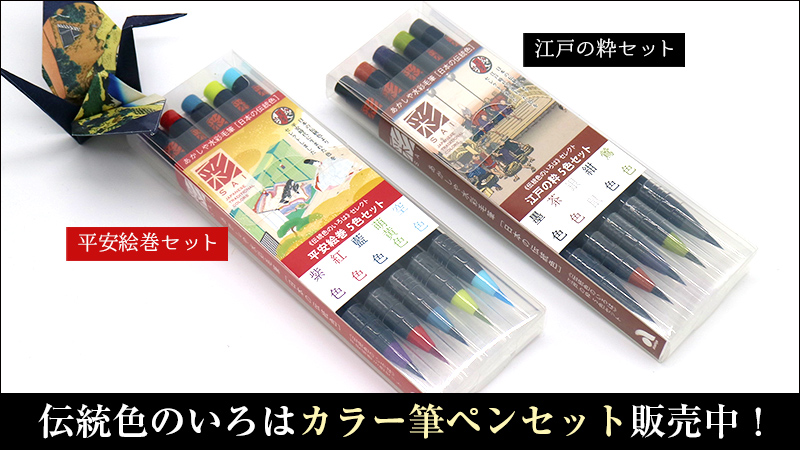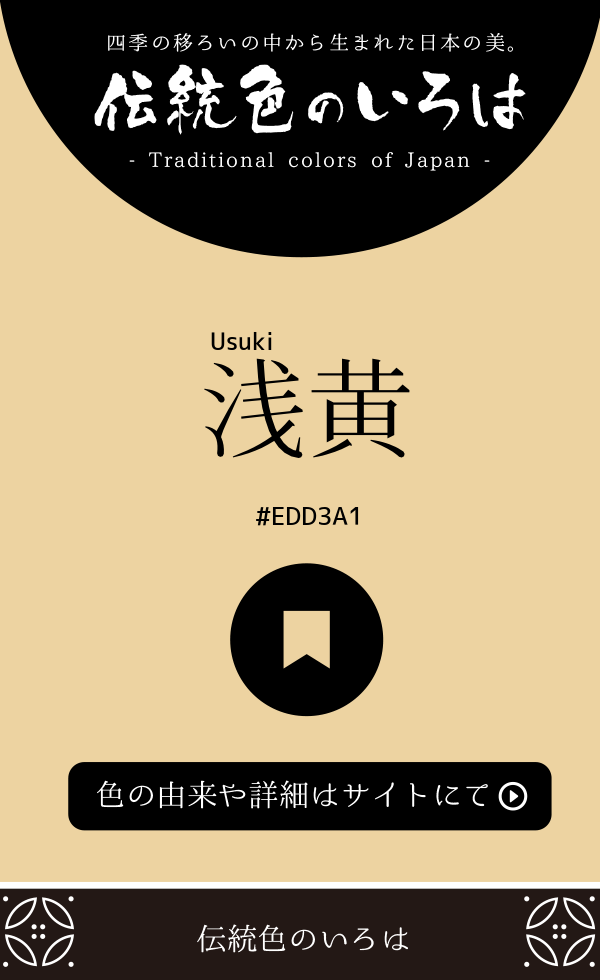| 色の名前Japan Color Name | 浅黄(うすき) |
|---|---|
| ローマ字Romanized | Usuki |
| RGB | R:237 G:211 B:161 |
| CMYK | C:00 M:11 Y:32 K:07 |
| Web カラーHex triplet | |
| 誕辰色 | 2月19日 |
色の説明
浅黄(うすき)は、苅安草と灰汁で浅く染めたうすい黄色のことです。平安時代の格式『延喜式 』にも記された古い色名で、『深黄色 』の対色。古い呼び名は「あさぎ」、別に「あさきき」「あさき」とも読まれます。
古くから浅い藍色の『浅葱色 』と混同された色で、平安後期の歴史物語『今鏡 』にも「あさぎと日記に侍 なるをば『青き色か、黄なる色か』などおぼつかなてく、」と書かれています。
近世になっても「浅黄」と書いて『浅葱色』を指すことが多く、江戸時代では『浅葱色』との混同を避けるため、うすい黄色には『薄玉子 』と呼んで区別しました。また、混同を避けるために「うすき」の読みが定着したのでしょう。
『浅黄』の染料は『延喜式』縫殿寮 の雑染用度によれば「綾一疋に、苅安草大三斤八両、灰一斗二升、薪三十斤。」とあり、対色の『深黄』の用度が『綾一疋に、苅安草大五斤、灰一斗五升、薪六十斤。』とあるので、苅安の用度の差により『浅黄』の黄色の濃度を知ることができます。
※綾 は無地染めの綾織りの絹。一疋 は二反 分の長さで22m前後。
※一斤は約600g。両は1/16斤で約37.3g。
※斗は18リットル、升は1/10斗で1.8リットル。
一説に新選組の羽織の色は『浅葱』ではなく、『浅黄』だとする説もあります。
これは当時の資料に羽織の色を『浅黄』と表記するものが多く見られるからです。
ただし、近代まで当て字をすることはそれほど珍しくなかったため「浅黄」と書いて『浅葱』を指していた可能性も十分にありえます。

-読み:うすき-
「おさよ黒の衣、手甲脚半、浅黄の帽子を冠り出で」
『小袖 曽我 薊 色縫 (十六夜清心 )』歌舞伎脚本。河竹黙阿弥。安政六年(一八五九)江戸・市村座初演。
関連する色の紹介
[Explanation of a color]
The Usuki is a light yellow dyed lightly with persimmon and lye. It is an old color name written in the "Heisei-style" Enki-style, and is the opposite of "Fukakiki". The old name is read as “Asagi” and “Asakiki” and “Asaki” separately.
It is a color confused with the shallow indigo “Asagi-iro” since ancient times, and the history story of the late Heian period “Imagami” also “is blue and yellow” , "Is written.
Even in the early modern days, it was often written “浅黄” to refer to “Asagi-iro”. In order to avoid confusion with “Asagi-iro” in the Edo period, it was called “Usutamago” for light yellow. . Also, to avoid confusion, the reading “Usuki” would have taken root.
There is a theory that the color of the new group's haori is not “Asagi-iro” but “Usuki”. This is because there are many materials in which the color of haori is written as “浅黄” in the materials at the time.
However, since it was not uncommon to write characters until modern times, it is quite possible that the word “Asagi-iro” was written as “浅黄”.
-read:Usuki-
参考書籍
- 長崎盛輝『新版 日本の伝統色 その色名と色調』青幻舎 ISBN-10:4861520711
- 吉岡幸雄『日本の色辞典』紫紅社 ISBN-10:4879405493
- 内田 広由紀『定本 和の色事典』視覚デザイン研究所 ISBN-10:4881082035
注意事項
表示されている色(RGB値)は色の名前に対するおおよそものです。色名によっては広範囲の色を指す場合や文献・書籍等によっては解釈が異なる場合もありますのでご了承ください。 ご利用の環境によっては、色が適切に表示されていない場合があります。
印刷などに伝統色を利用したい場合は、DICグラフィックス株式会社から発売されている日本の伝統色シリーズがオススメです。
タグ:江戸の色
Pinterestでシェアする際にご利用ください。
サイト運営者からのお願い
このサイトが気に入った、役に立ったと思われた方は、Amazon・楽天で買い物をする際はぜひ下記のバナーをタップしてからお買い物をお願いいたします。
こちらからお買い物をしていただきますと、価格の1%相当のポイントがサイトに入ります。もちろんその分、高くなるようなことはありません。
いただいたポイントは今後のサイト運営のための書籍代や運営費、モチベーションにつながりますので、ご協力いただけますと嬉しいです。

 DIC 日本の伝統色 第9版
DIC 日本の伝統色 第9版



